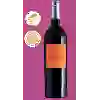
Winery SinglaHéritage du Temps Rivesaltes Ambré
This wine generally goes well with
The Héritage du Temps Rivesaltes Ambré of the Winery Singla is in the top 10 of wines of Rivesaltes.
Wine flavors and olphactive analysis
On the nose the Héritage du Temps Rivesaltes Ambré of Winery Singla in the region of Languedoc-Roussillon often reveals types of flavors of oaky, plum or chocolate and sometimes also flavors of caramel, raisin or prune.
Details and technical informations about Winery Singla's Héritage du Temps Rivesaltes Ambré.
Discover the grape variety: Meunier
Meunier noir is a grape variety that originated in France (Champagne). It produces a variety of grape specially used for wine making. It is rare to find this grape to eat on our tables. This variety of grape is characterized by small bunches and small grapes. Meunier noir can be found in many vineyards: South West, Cognac, Bordeaux, Loire Valley, Champagne, Burgundy, Jura, Languedoc & Roussillon, Beaujolais, Lorraine, Provence & Corsica, Rhone Valley, Savoie & Bugey.
Last vintages of this wine
The best vintages of Héritage du Temps Rivesaltes Ambré from Winery Singla are 1980, 2005, 2016, 2004 and 2002.
Informations about the Winery Singla
The Winery Singla is one of of the world's greatest estates. It offers 28 wines for sale in the of Rivesaltes to come and discover on site or to buy online.
The wine region of Rivesaltes
Rivesaltes is an appellation for the historic Sweet wines of eastern Roussillon, in the DeepSouth of France. The natural sweet wines produced in this region have been revered since at least the 14th century. The technique used to make them is one of many techniques used for sweet wines. Unlike botrytized wines or ice wines, natural sweet wines are made by Mutage, a process that involves stopping the Fermentation of the must while a high level of natural sweetness remains.
The wine region of Languedoc-Roussillon
Languedoc (formerly Coteaux du Languedoc) is a key appellation used in the Languedoc-Roussillon wine region of southern France. It covers Dry table wines of all three colors (red, white and rosé) from the entire region, but leaves Sweet and Sparkling wines to other more specialized appellations. About 75% of all Languedoc wines are red, with the remaining 25% split roughly down the middle between whites and rosés. The appellation covers most of the Languedoc region and almost a third of all the vineyards in France.
The word of the wine: Heida
See savagnin.














